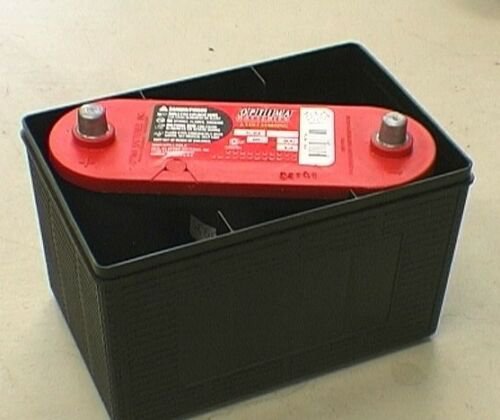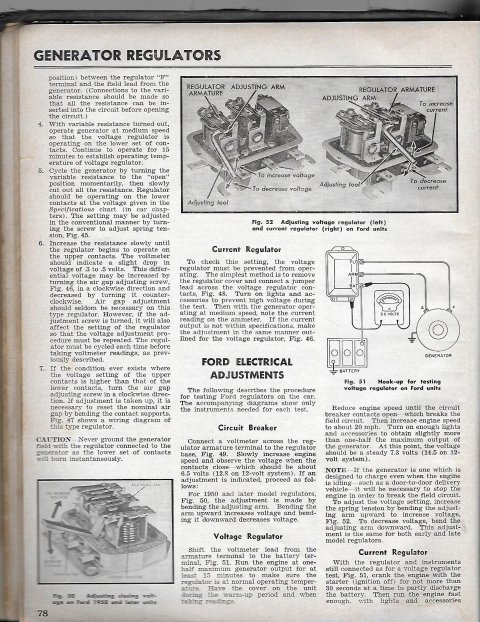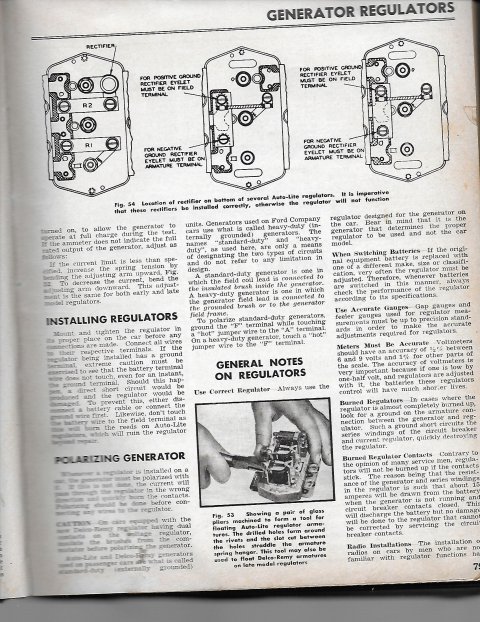The charging system consists of the battery and cables, the generator and an external voltage regulator. The function of the battery is to spin the starter motor to start the engine. Once that’s done the generator takes over, satisfying the car’s electrical demands and keeping the battery charged. The battery then acts primarily as a filter, keeping voltage spikes from damaging the car’s electronics. The voltage regulator rapidly switches the alternator in and out of the charging circuit to provide the car with the correct voltage.
In 1955, the electrical system of the Thunderbird was 6 volt positive ground. In 1956, the Thunderbird electrical system was changed to 12 volt negative ground. On the 12 volt system there are two important numbers to remember, they are 12.6 volts and 13.5 volts.
12.6 Volts: If you think your car has a 12 volt battery, it doesn’t. The 12 volt battery actually has six individual 2.1 volt cells (one under each fill cap). Thus, when fully charged, the battery should have a resting voltage of 12.6 volts. If with the engine off, the resting voltage is less than 12.6 volts, the battery is low and needs to be recharged. Of course, it begs the question of why the battery is low. It could be that the generator isn’t working, or that the battery has reached the end of its useful life.
13.5 Volts: With the engine running, the alternator should output a charging voltage that’s about a volt higher than the resting voltage, or about 13.5 volts. The exact charging voltage may be as low as 13.2 volts or as high as 14.2 volts.
If your Thunderbird is a 1955, with a 6 volt, positive ground system, the resting voltage is 6.3 volts and the charging voltage should be about 7.1 volts. The exact charging voltage may be as low as 6.6 volts or as high as 7.1 volts.
Take a multi-meter and set it to measure DC voltage, then measure the voltage across the positive and negative battery terminals with the engine off. On a 12 volt system, a fully charged battery should read a resting voltage of 12.6 volts. After you start the car you should see a charging voltage of about a volt higher than resting voltage. If the reading doesn’t increase by about a volt or if it stays at the resting voltage, it means that the generator isn’t recharging the battery. This could be because the generator is defective, the regulator is defective, or the wiring between them has failed. In any case, if you drive the car, the battery will run down. If the battery runs down enough that the ignition stops firing, the engine will stall. It’s really important that you don’t simply jump-start a car with a dead battery without checking to see if the alternator is charging.
A basic charging system health test: Use a multi-meter to measure the resting and charging voltages as described above. Then, with the engine running, gradually increase the electrical load by turning on the headlights and the blower fan. Then increase the engine RPM to about 3,500 as you watch the reading on the multi-meter. If the voltage stays about a volt higher than resting voltage, then the car’s charging system is functioning. But if the voltage drops or increases dramatically at any point, there’s a problem with the generator or the voltage regulator.
doug7740
1955 Thunderbird Blue






